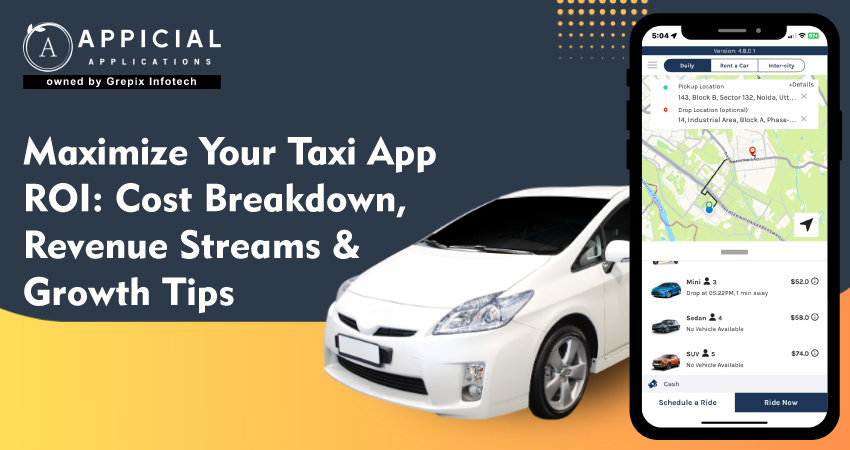
Maximise Your Taxi App ROI: Cost Breakdown, Revenue Streams & Growth Tips
Understanding the ROI of a taxi app is crucial before you invest in building a mobility platform. Without clarity on expected return, you risk overspending on development, infrastructure or marketing and failing to generate enough revenue to justify the investment.
A ride-sharing app or ride-hailing app is not simply a tech product; it is a business. You need to treat it as such. When you involve a taxi app development company, you should ask for cost estimates, revenue potential and ROI scenarios. Knowing your taxi app cost and forecasting your taxi business revenue helps align your resources and set realistic goals.
A robust business case, including profit assumptions for the taxi app, will guide your decisions. Before you launch, you should ask: How much will it cost? What revenue streams can I exploit? When will I break even?.This blog will cover those questions in depth.
This blog explains why understanding taxi app ROI matters before you launch a mobility solution. It walks you through how to calculate ROI with a clear formula and a worked example. We break down the major cost components, including app development, server infrastructure, marketing, and maintenance. Then we explore the major revenue streams: commissions, driver fees, ads, and subscriptions. Next, we show how to forecast your break-even point (for example, at 8–12 months). We finish with five actionable tips to increase ROI, optimising fares, loyalty programmes, referral plans and more. Throughout, we reference the role of a taxi app development company and the broader ride-sharing, ride-hailing, and e-hailing app industry context.
How to calculate ROI?
When we talk about taxi app ROI, it simply means- how quickly you can recover the money you invested in the app. If you purchase a white-label taxi app from a taxi app development company like Appicial Applications, your total taxi app cost is usually between USD 7,000 and 10,000.You receive the fully functional app, including rider app, driver app, and admin panel, within 3–4 weeks of development and setup.
Once your app goes live, your real focus should shift to driver onboarding.The more drivers you have, the faster your taxi business revenue grows and the sooner you recover your investment.Each active driver earns daily ride commissions that accumulate quickly.
If you reach the right number of active drivers within the first 3 months, you can easily recoup your investment and achieve 100% ROI (or more) within half a year.
Taxi App ROI Estimation Based on Active Drivers
| Active Drivers | Avg. Daily Rides per Driver | Monthly Ride | Avg. Fare / Ride (USD) | Total Fare (USD) | Owner Earning (20% off) (USD) |
|---|---|---|---|---|---|
| 30 Drivers | 5 | 4500 | 5 | 22500 | 4500 |
| 100 Drivers | 5 | 15000 | 5 | 75000 | 15000 |
| 300 Drivers | 5 | 45000 | 5 | 225000 | 45000 |
| 700 Drivers | 5 | 105000 | 5 | 525000 | 105000 |
| 1000 Drivers | 5 | 150000 | 5 | 750000 | 150000 |
ROI Analysis and Key Insights
The ROI, or Return on Investment, shows how quickly the platform owner can recover their initial investment based on the income earned from drivers.First, we find the total number of rides each month by multiplying the number of drivers by their average daily rides and then by 30 days. Then, we multiply this number by the average fare per ride (USD 5) to get the total amount collected from passengers.
Since the platform owner earns a 20% commission, we take 20% of the total fare to find the owner’s monthly earnings. For example, with 30 drivers, the total monthly fare is USD 22,500, and the owner earns USD 4,500. If the initial investment is USD 8,000, it would take about 1.8 months to recoup that amount.
As the number of drivers increases, the owner’s monthly earnings grow, and the time required to recover the investment shortens. For instance, with 100 drivers, the ROI time drops to about half a month, and with 1,000 drivers, the investment can be recovered in just a few days. This shows that the more drivers the platform has, the faster it can make a profit.
Major revenue streams: commission, driver fees, ads, subscriptions
To achieve strong profit margins in a taxi app, you should diversify your revenue streams. A modern taxi business revenue model may include:
- Commission per ride - The most direct stream. The platform takes a percentage (e.g., 20-30%) of each ride's value.
- Driver fees/subscription - You may charge drivers a subscription or fee to stay on your platform, or for advanced features. These aids recurring income for your ride-hailing app business.
- In-app advertising - Your e-hailing app can host ads from related services, fuel, vehicle insurance, and local businesses. As user engagement grows, ad revenue adds up.
- Premium subscriptions - Offer riders a subscription to waive cancellation fees, secure certain fare caps, and priority booking. This increases average revenue per user. A white-label taxi booking app developed by a taxi app development company can include a subscription module.
- Additional services - Beyond rides: deliveries, corporate tie-ups, airport transfers, loyalty programmes. These add incremental revenue and help your ROI.
Bonus: 5 Tips To Increase Roi (Optimize Fares, Loyalty Programs, Referral Plans)
To boost your taxi app ROI and improve taxi app profit, adopt these five actionable strategies:
- Optimise fare structure: - Balance competitiveness and profitability. Use dynamic pricing intelligently, apply minimum fares, and reduce empty driver miles.
- Implement loyalty programmes: - Reward frequent riders with discounts or points. These increases repeat usage, lower user-acquisition costs, and boost lifetime value.
- Referral plans for riders and drivers: - Encourage users to refer new riders; incentivise drivers to bring on board peers. Referrals reduce marketing cost and accelerate growth. An e-hailing app can structure refer-and-earn models to channel organic growth.
- Use data analytics to refine operations: - Monitor metrics: driver idle time, ride completion rate, cancellation rate, average fare, and peak zones. A platform that uses analytics will optimise driver allocation, reduce costs, and enhance user satisfaction. Your taxi app development company should integrate analytics dashboards.
- Expand services & monetise beyond rides: - Introduce rentals, corporate contracts, subscription services, and ad partnerships. Diversify revenue to improve your taxi business revenue mix.
Learn More: Everything You Need to Know Before Starting a Taxi App Business
Conclusion
Launching a ride-sharing app, ride-hailing app, or e-hailing app without a clear understanding of taxi app cost, revenue streams, and ROI is risky. By calculating ROI, breaking down major cost components, preparing for break-even and deploying growth tactics, your taxi business will be set on the path to success. If you partner with a competent taxi app development company or a white label taxi app development company, you gain expertise in development, monetisation, analytics and operations.
At Appicial Applications, we specialise in building full-featured taxi app solutions that deliver real ROI. From cost-efficient development to integrated analytics, referral modules, loyalty engines and diverse monetisation, we build for the future.
Ready to calculate your taxi app ROI and launch with confidence? Talk to our experts at Appicial Applications today.
FAQs
Author's Bio

Vinay Jain is the Founder at Grepix Infotech and brings over 12 years of entrepreneurial experience. His focus revolves around software & business development and customer satisfaction.
Back to blog list




